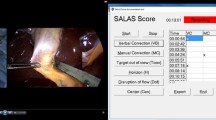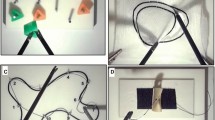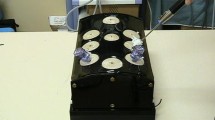Abstract
Background
Minimal access surgery is associated with increased risk of complications, particularly early in a surgeon’s laparoscopic career. This is mostly due to loss of depth cues, degraded tactile feedback from surgical instrument, and the “fulcrum effect”. Degraded and restricted image on the monitor makes camera orientation very important. The objective of this study is to investigate the effects of camera rotation on laparoscopic performance.
Methods
In two separate studies 100 laparoscopic novices and 7 experienced laparoscopic surgeons (> 300 laparoscopic procedures) were asked to perform a simple laparoscopic cutting task and tie intracorporeal square-knots (respectively) under 0°, 15°, 45°, 90°, and 180° camera rotation.
Results
In study 1 camera rotation significantly degraded performance of laparoscopic novices (p < 0.00001) and also increased their error rate (p < 0.00001). In study 2 camera rotation significantly increased the length of time it took surgeons to tie an intracorporeal square-knot (p < 0.00001) and the number of errors made (p < 0.0001).
Conclusions
Unintentional camera rotation during surgery should be avoided to eliminate one potential source for errors.






Similar content being viewed by others
References
Deziel D, Milikan KW, Economou SG, Doolas A, ST Ko, Airan MC (1993) Complications of laparoscopic cholecystectomy: a national survey of 4,292 hospitals and an analysis of 77,604 cases. Am J Surg 165:9–14
Club The Southern Surgeons (1995) The learning curve for laparoscopic cholecystectomy. Am J Surg 170:55–59
Van Veelen M, Jakimowicz JJ, Goossens R, Meijer DW, Bussman H (2001) Evaluation of the usability of two types of image display systems during laparoscopy. Eur Assoc Endosc Surg Maastrich, Netherlands
Reinhardt-Rutland AH, Gallagher AG (1996) Visual depth perception in minimally invasive surgery. In: Robertson SA (ed) Contemporary ergonomics. Taylor Francis, London, pp 531–536
Hanna GB, Cuschieri A (2000) Influence of two-dimensional and three-dimensional imaging on endoscopic bowel suturing. World J Surg 24:444–448
Hanna GB, Shimi SM, Cuschieri A (1998) Randomised study of influence of two-dimensional versus three-dimensional imaging on performance of laparoscopic cholecystectomy. Lancet 351:248–251
Gallagher AG, McClure N, Ritchie K, McGuigan J, Sheehy N (1998) An ergonomic analysis of the fulcrum effect in endoscopic skill acquisition. Endoscopy 30:617–620
Bruce V, Green P (1985) Visual perception: physiology, psychology and ecology. Lawrence Erlbaum, London
Jordan JA, Gallagher AG, McGuigan J, McClure N (2000) Randomly alternating image presentation during laparoscopic training leads to faster automation to the ‘fulcrum effect’. Endoscopy 32:317–321
Jordan JA, Gallagher AG, McGuigan J, McGlade K, McClure N (2000) A comparison between random randomly alternating imaging, normal laparoscopic imaging and virtual reality training in laparoscopic psychomotor skill acquisition. Am J Surg 180:208–211
Jordan JA, Gallagher AG, McGuigan J, McClure N (2001) Virtual reality training leads to faster automation of the novel psychomotor restrictions encountered by laparoscopic surgeons. Surg Endosc 15:1080–1084
Crothers IR, Gallagher AG, McClure N, James D, McGuigan J (1999) Experienced laparoscopic surgeons are automated to the fulcrum effect: An ergonomic demonstration. Endoscopy 31:365–369
Medina M (1997) Image rotation and reversal–major obstacles in learning intracorporeal suturing and knot-tying. J Soc Lap Surg 4:331–336
Poulin EC, Mamazza J, Litwin DEM, Nagy AG, Girotti MJ (1992) Laparoscopic cholecystectomy; Strategy and concerns. Can J of Gen Surg 35:285–289
Conrad J, Shah AH, Divino CM, Schluender S, Gurland B, Shlasko E, Szold A (2006) The role of mental rotation and memory scanning on the performance of laparoscopic skills: a study on the effect of camera rotational angle. Surg Endosc 20:504–510
Schmidt RA (1988) Motor control and learning: a behavioral emphasis, 2nd edn. Human Kinetics, Champaign, IL, USA
Cao CG, Milgram P (2000) Case studies of disorientation in minimally invasive surgery. Proceedings of the 44th annual meeting of the human factors and ergonomics society, San Diego, CA,
Kohn LT, Corrigan JM, Donaldson M (1999) To err is human: building a safer health system. Institute of Medicine, Washington, DC
Reason J (1994) Human error. Cambridge University Press, Cambridge
Gallagher AG, McClure N, McGuigan J, Crothers I, Browning J (1999) Virtual reality training in laparoscopic surgery: a preliminary assessment of Minimally Invasive Surgical Trainer Virtual Reality (MIST VR). Endoscopy 31:310–313
Gigot J-F, Etienne J, Aerts R, Wibin E, Dallemange B, Deweer F, Fortunati D, Legrand M, Vereeken L, Doumont J-E, Van Reepinghen P, Beguin C (1997) The dramatic reality of biliary tract injury during laparoscopic cholecystectomy; an anonymous multi-center survey of 65 patients. Surg Endosc 11:1171–1178
Ganai S, Donroe JA, St Louis MR, Lewis GM, Seymour NE (2007) Virtual-reality training improves angled telescope skills in novice laparoscopists. Am J Surg 193:260–265
Acknowledgements
The authors wish to thank N. Gabriel and J. C. Rosser Jr. for their contribution and support during the second study reported here.
Author information
Authors and Affiliations
Corresponding author
Rights and permissions
About this article
Cite this article
Gallagher, A.G., Al-Akash, M., Seymour, N.E. et al. An ergonomic analysis of the effects of camera rotation on laparoscopic performance. Surg Endosc 23, 2684–2691 (2009). https://doi.org/10.1007/s00464-008-0261-x
Received:
Revised:
Accepted:
Published:
Issue Date:
DOI: https://doi.org/10.1007/s00464-008-0261-x




